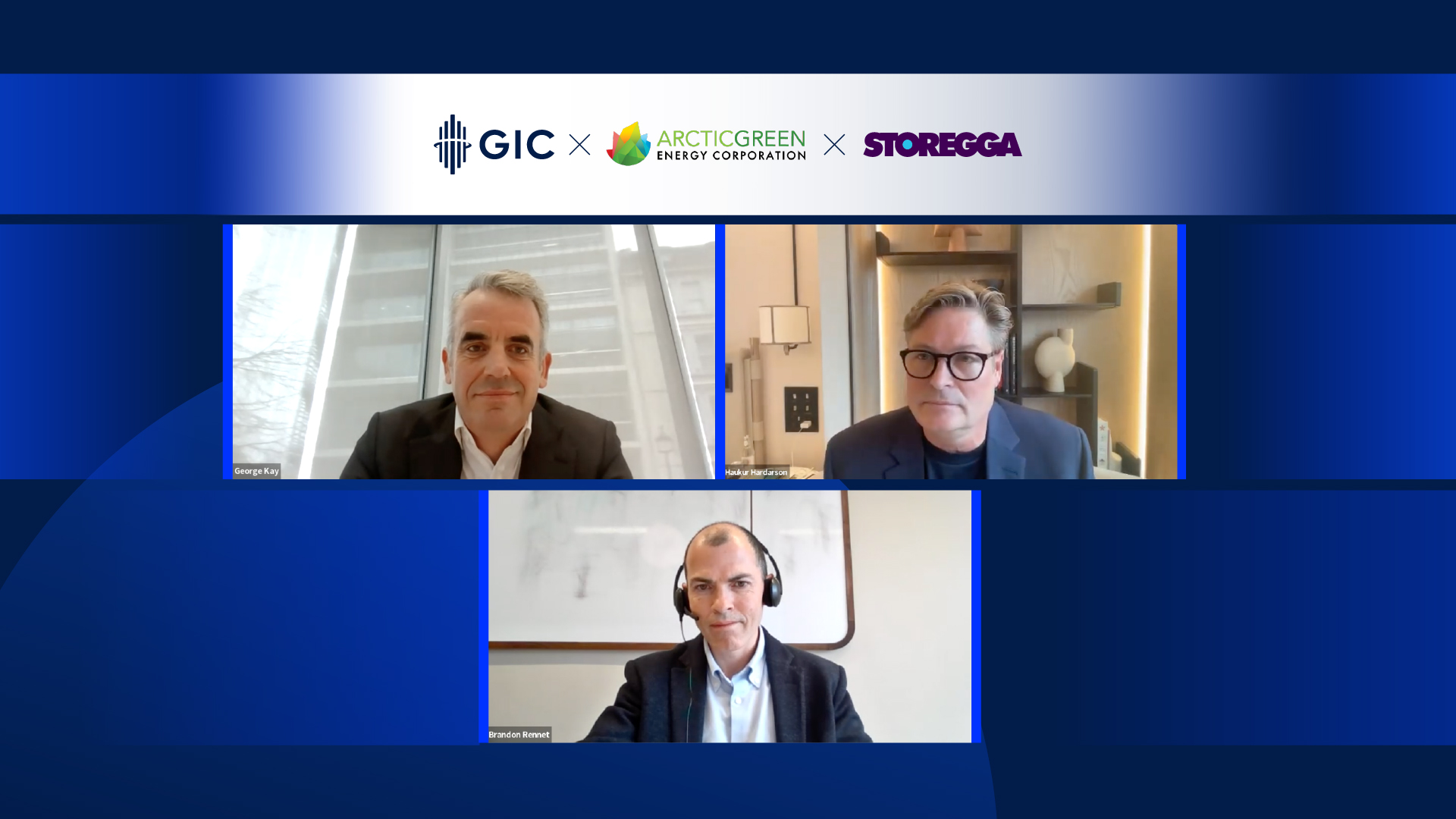This is an edited transcript of the GIC Speakers’ Series – Sustainability Edition with Brandon Rennet, CFO of carbon reduction and removal firm, Storegga, and Haukur Hardarson, Chairman and Founder of renewable energy firm, Arctic Green Energy. The pair were interviewed by George Kay, Head of Infrastructure for Europe, GIC about their vision for the energy transition and the key challenges and opportunities both companies face.
The impact of energy shocks on the road to net zero
GEORGE: With widespread energy market disruptions this year and record-high oil and gas prices particularly in Europe, security of supply concerns are coming to the forefront. What impact has that had on the work that Storegga and Arctic Green do?
BRANDON: There is a well-established energy trilemma – balancing security of supply with affordability and environmental considerations. That framework is extremely relevant right now. Clearly, security of supply in Europe has shot up on the agenda and so have affordability concerns. But the question to me really is – what is the true cost of delaying action on the environmental agenda? It seems clear that the environmental concerns, which are so fundamental, cannot be dealt with in the same way as has been done in the past.
With the Russia-Ukraine war, we are seeing some willingness to rely more on non-Russian hydrocarbons. But overall, it makes very little sense to increase our dependency on fossil fuels at a time when we have seen them being weaponised. It is much better to advance investments in renewables, electrification, hydrogen, carbon capture and storage (CCS), and direct air capture. The situation in Ukraine may further drive that shift to energy independence and hence to renewables and low-carbon tech. Indeed, we have already seen an increase in demand. With the passage of time, we will see a broader and longer-term focus on affordability, allowing the environmental agenda to go right back into the top spot in that energy trilemma.
HAUKUR: Disruptions and high oil prices create tremendous opportunities for companies like Arctic Green in Europe. Not many people are familiar with the landscape for total global energy usage. Electricity only accounts for 20%. Heating, instead, takes up over half of total global energy usage. This is also where the dirtiest fossil fuels are burnt.
With our projects in Europe, we have emphasised that clean heating for cities is not just a climate issue but also one of energy security. The current energy crunch has exposed economic vulnerabilities around the world, with the worst impacts – short supply and rising prices – hitting the most vulnerable the hardest.
There is an enormous opportunity for us to meet both the demand for decarbonisation and to deal with rising prices by providing clean heat to European cities. Geothermal meets both the requirements of decarbonisation and energy security, while also enhancing human health and the environment. It reduces air pollution by transitioning from fossil fuels to clean energy sources, and it also offers a domestic source of energy that can significantly contribute to energy security outside of the traditional geopolitical power structure, largely based on fossil fuels.
Creating an enabling regulatory environment for the energy transition
GEORGE: Both Arctic and Storegga have extensive partnerships with governments and regulators – could you talk about the role both play in helping to facilitate the energy transition?
BRANDON: Governments around the world have a critical role to play in helping to stimulate this new sector quickly. Fundamentally, they are trying to address an issue of market failure. It’s crystal clear that the true cost of environmental damage that greenhouse gases rack up is just not being priced into any market effectively now, so we need that government intervention. That either comes in the form of a stick, such as the carbon taxes introduced in many countries, or as a carrot, such as the tax credits that you see in the US. In the UK, we are also seeing tried and tested forms of economic regulation used to bridge that gap. The Regulatory Asset Value Model and Contracts for Difference (CFD) are some examples.
Governments also need to provide sufficiently supportive environments to allow first movers to act with some degree of mitigation of the risks that they normally face. In relation to Storegga, we are looking to develop Europe’s first large-scale direct air capture plant in the northeast of Scotland. Now, the first-of-a-kind risk here is significant, because there’s inevitably going to be substantial efficiency gains as subsequent generations of that technology are developed and become more commercial without any subsidy. Finding a way to allow the first generation of plants to remain relevant and competitive isn’t going to happen on a pure level playing field without any form of support.
HAUKUR: Because we provide heat to cities via geothermal, we are much more regulated and dependent on government collaboration compared to other forms of renewable energy. From exploration to drilling, to what we do with the used geothermal water, to the end-user prices, this is all highly regulated both at the national and regional level.
For us, collaboration with regulators is an ongoing process. In our work with governments, we have contributed to shaping policies. This comes as we evaluate the merits of geothermal energy with policymakers and even contribute to discussions about where geothermal belongs in terms of area of regulation. In some countries it is regulated under the Renewables Act, while in others it could come under their Mining Act, or even their Water Act.
One positive outcome from our cooperation with governments is that they have become an unofficial advocate for our solutions. Especially if they are involved with us in building the pricing mechanisms and focus on decarbonisation goals, the governments we work with have the potential to become our strongest allies.
The role of carbon markets
GEORGE: What are your views on the development of carbon markets?
BRANDON: It’s clear that the energy transition must be supported by strong and stable carbon markets. Yet carbon markets in themselves can be blunt instruments, and they don’t always incentivise an efficient change of behaviour. Depending on the form of policy or regulatory support provided, carbon markets can be useful in providing a foundation upon which other measures can be built. Contracts for Difference are one example.
From an industry perspective, what we need to see is progressive, long-term, consistent, and clear policy definition to drive decarbonisation on a deliverable basis. Governmental commitments around net zero are critical. Making them legally-binding has made a big difference in this part of the world.
HAUKUR: Carbon markets have huge potential to accelerate the energy transition. For our industry, carbon markets could open significant new revenue streams as fossil energy is displaced.
The amount of carbon savings by geothermal heating is off the charts. Just to give you a feel for it, our carbon savings this year in China alone will be 4.2 million tonnes and has the potential to eventually exceed 20 million tonnes annually. We are still waiting for more specific protocols on how to monetise the credits, and we need a transparent regulatory framework, a broadly accepted certification standard, and a consolidated market to drive that.
Today, there are too many standards competing. In the future, however, we will likely see fewer and more broadly accepted standards. Institutional investors and large equity funds need standardised products and methods to model carbon benefits that are compatible and certifiable. Finally, we need meaningful carbon prices, and to be able to trade transparently within both volunteer and compliance carbon markets.
GEORGE: What kind of carbon tax price range is required for CCS projects to be economically viable currently? Is it expected to evolve over the next decade?
BRANDON: It depends on the specific project really. With the Acorn project we are doing in the North Sea, we are reusing a lot of existing infrastructure. In that case, most gas pipelines are already there, which helps with the cost. We have seen carbon prices reach EU$100/tonne not that long ago. If we saw that increase by another 30-50%, it would get us to a position where we could probably complete the project without the need for any additional direct subsidy.
If you look in the US, the 45Q tax credit effectively gives you about US$50/tonne now and it might increase to about US$85/tonne. There is a project we are involved in called Freeport LNG. In that case, you have one emitter, with the storage site about a mile away. There’s a very pure stream of CO2 that’s coming from the plant, so there the incremental infrastructure cost is, to put it in simplified terms, what it takes to extend that pipe, take it about a mile away, drill a couple of wells, and place the relevant compressors around it. The infrastructure cost is low compared with a big offshore store. In that case, you could make US$50/tonne workable with a decent return.
If we are looking at direct air capture, it’s relatively expensive at the moment. It would probably cost about £400/tonne for that technology now. We do think that it will be possible to radically cut costs closer to £150/tonne, and relatively quickly as the number of projects ramps up and the technology is rolled out globally. But even at that level, we are seeing quite a lot of demand from customers. These are usually industries like aviation or industries that are hyper focused on their reputation and have relatively deep pockets like big tech firms.
Many firms right now are making commitments to becoming net zero by 2030, with often not a clear roadmap of how to get there. Now they might get close to their target eventually, but then may have to decide – are we prepared to pay a premium to buy some additional high-quality credits that can help us hit our target? I see a lot of companies out there who might be prepared to pay a real premium in the not-too-distant future to have access to projects like the ones Storegga and Arctic Green are offering.
GEORGE: It’s great to hear your optimism about the future. At GIC, we are excited to be investing in your companies to help accelerate the green transition. It essentially exemplifies what it takes to do both good and do well – investing in the global energy transition, while working towards securing good long-term returns.







